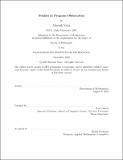Studies in program obfuscation
Author(s)
Varia, Mayank (Mayank Harshad)
DownloadFull printable version (916.9Kb)
Other Contributors
Massachusetts Institute of Technology. Dept. of Mathematics.
Advisor
Ran Canetti.
Terms of use
Metadata
Show full item recordAbstract
Program obfuscation is the software analog to the problem of tamper-proofing hardware. The goal of program obfuscation is to construct a compiler, called an "obfuscator," that garbles the code of a computer program while maintaining its functionality. Commercial products exist to perform this procedure, but they do not provide a rigorous security guarantee. Over the past decade, program obfuscation has been studied by the theoretical cryptography community, where rigorous definitions of security have been proposed and obfuscators have been constructed for some families of programs. This thesis presents three contributions based on the virtual black-box security definition of Barak et al [10]. First, we show tight connections between obfuscation and symmetric-key encryption. Specifically, obfuscation can be used to construct an encryption scheme with strong leakage resilience and key-dependent message security. The converse is also true, and these connections scale with the level of security desired. As a result, the known constructions and impossibility results for each primitive carry over to the other. Second, we present two new security definitions that augment the virtual black-box property to incorporate non-malleability. The virtual black-box definition does not prevent an adversary from modifying an obfuscated program intelligently. By contrast, our new definitions provide software with the same security guarantees as tamper-proof and tamper-evident hardware, respectively. The first definition prohibits tampering, and the second definition requires that tampering is detectable after the fact. We construct non-malleable obfuscators of both favors for some program families of interest. Third, we present an obfuscator for programs that test for membership in a hyperplane. This generalizes prior works that obfuscate equality testing. We prove the security of the obfuscator under a new strong variant of the Decisional Diffie-Hellman assumption that holds in the generic group model. Additionally, we show a cryptographic application of the new obfuscator to leak-ageresilient one-time digital signatures. The thesis also includes a survey of the prior results in the field.
Description
Thesis (Ph. D.)--Massachusetts Institute of Technology, Dept. of Mathematics, 2010. This electronic version was submitted by the student author. The certified thesis is available in the Institute Archives and Special Collections. Cataloged from student submitted PDF version of thesis. Includes bibliographical references (p. 159-164).
Date issued
2010Department
Massachusetts Institute of Technology. Department of MathematicsPublisher
Massachusetts Institute of Technology
Keywords
Mathematics.